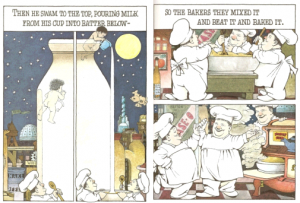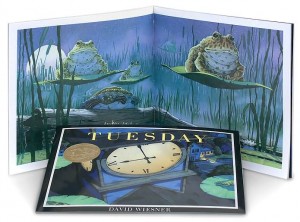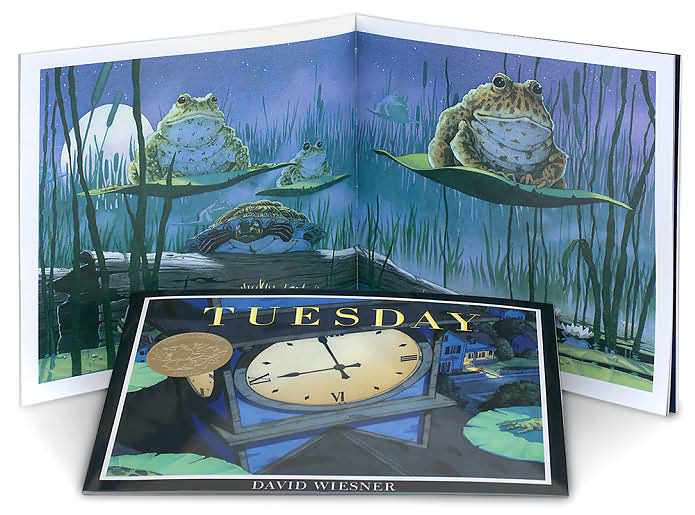If you Google “world building,” you receive 773,000,000 search results. The top results nearly all lead to blogs or websites focused on writing about this world. As an illustrator, you’re not writing about a world, but you need to create one, none the less.
One difference between a piece of fine art and an image in a picture book is creating this world. When you illustrate an image, you are in essence becoming a story-teller. Your characters aren’t out there floating in a vacuum, are they? They are most likely doing something very specified in a very specific locations. It’s your job to engage in world building to show the reader just what this place, this world is all about.
Nine times out of ten, the world building advice on writer’s blogs has to do with the creation of a science fiction or fantasy world and the believability of the magical elements. However, the advice on these blogs can be translated to the picture book worlds you are attempting to describe with your art. When composing your pencil sketches think about who your character is. If the main character is a 4-year-old boy in his room, what is his room like? Does he like books? How about dinosaurs or trains? Is he a neat child or a messy one? Does he have a pesky younger sister who gets into his stuff? What time of day is it? Are there curtains on his windows? Is he afraid of the dark? Does he have a pet? You get the idea. Ask your character what he likes, what he wants and where he does all this.
 Maurice Sendak was an excellent world builder. Nearly everyone is familiar with his book “Where the Wild Things Are.” The images in this book tell so much about naughty Max and his loving but overwhelmed mother. Another of Mr. Sendak’s books (my absolute favorite of his), In the Night Kitchen is another example of strong world building.
Maurice Sendak was an excellent world builder. Nearly everyone is familiar with his book “Where the Wild Things Are.” The images in this book tell so much about naughty Max and his loving but overwhelmed mother. Another of Mr. Sendak’s books (my absolute favorite of his), In the Night Kitchen is another example of strong world building.
In the image at the left, Mr Sendak has combined the two worlds of mundane and other worldly by a star lit background, a huge bottle of milk and the rather bulbous nosed bakers mixing a huge bowl of batter that gets placed in an oven. I’m old enough to remember glass milk bottles delivered at dawn by the milk man, and my grandmother has a stove very similar in appearance to the one shown.
In the story you are illustrating have you decided on the era? Is it modern, old-fashioned or futuristic? Is your main character an animal in clothing? If so, does the environment surrounding the animal match her personality? Think of classic stories like Chicken Little. It’s old-fashioned if you stick with the Mother Goose period version, but if you look at the Walt Disney 2005 movie version, it happens in a futuristic setting. The story line in both version is basically the same premise, but the world building used makes them two totally individual and dynamic places.
 The wordless books of David Wiesner like “Tuesday” and “Flotsam” build such strong worlds, the viewer is drawn into the story completely. Both of these books have elements of ordinary worlds as well as extraordinary ones.
The wordless books of David Wiesner like “Tuesday” and “Flotsam” build such strong worlds, the viewer is drawn into the story completely. Both of these books have elements of ordinary worlds as well as extraordinary ones.
Here we see the everyday world invaded by unexpected fantasy elements. It’s unexpected. It’s interesting. It’s even mesmerizing. And best of all, in the books, it’s totally believable.
Where do your characters live? Are they floating on a blank white page? Or a meaningless undefined color? Is that background you threw in there interesting? It should be. Think of the background in your image as a supporting character. Create a supporting character with as much depth and personality as your main character. Make the background, the world your main character inhabits, interesting enough, that if you remove the main character, there is still enough story going on to keep your reader’s attention.
____________
If you found this post helpful and are interested in receiving notifications when more portfolio builder advice is posted,
sign up for my mailing list.


 RSS - Posts
RSS - Posts